Challenges and Measures for Food Security in Nigeria
VerifiedAdded on 2023/03/20
|11
|1997
|32
AI Summary
This article discusses the challenges and measures for food security in Nigeria. It explores the driving forces, pressures, state, exposure, effects, and actions taken by the government to address the issue. The article also highlights the need for strengthening policy frameworks and investment planning for nutrition security interventions.
Contribute Materials
Your contribution can guide someone’s learning journey. Share your
documents today.
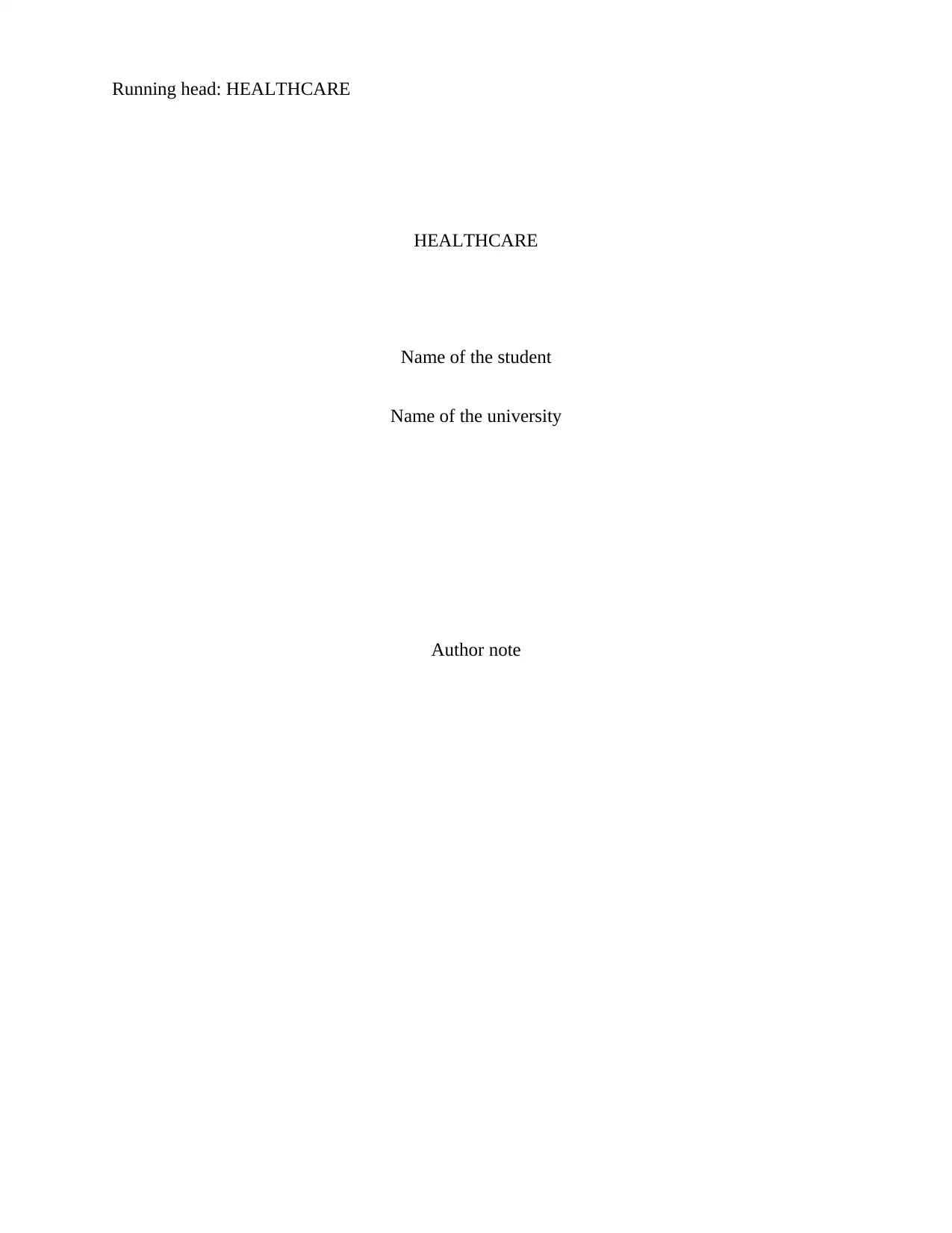
Running head: HEALTHCARE
HEALTHCARE
Name of the student
Name of the university
Author note
HEALTHCARE
Name of the student
Name of the university
Author note
Secure Best Marks with AI Grader
Need help grading? Try our AI Grader for instant feedback on your assignments.

HEALTHCARE 1
Introduction
The environmental factors are the ley and the root cause towards the significant burden of
disease in the developing countries. As per the reports by the World Health organization, an
estimated amount of 25% of the death and the global disease are linked to the environmental
hazards (FRAMEWORK FOR LINKAGES BETWEEN HEALTH, ENVIRONMENT AND
DEVELOPMENT, 2019). These includes unsafe and poor sanitation, malaria, air pollution, acute
poisoning, climate changes, lack of nutrition and food and more. The environmental risk
assessment aims to highlight some of the major challenges in the globe, that is the lack of
security of food at specific region, Nigeria which is in Africa.
Nigeria situated in Africa has attention for the lack in proper security of food and
nutrition throughout many years. The country has the historical record regarding the decreasing
rate of the low dietary supply of energy, nourishments together with higher rate of
multidimensional poverty and rural poverty rate (Adebayo et al., 2016). The scarcity of nutrition
and food that are influenced by the consumption and the production varies widely in the country.
Discussion
Part 1
The food health and safety indicators are the useful tools for the explanation of the
food hazards, the contamination pathways, the status of the exposure and the health related
effects in the terms of the public health. According to Ashagidigbi, Afolabi & Adeoye, (2017),
the DPSEEA framework is one of the most effective tool or the framework since it is divides the
chains of the causation towards the five domains from the distal towards the proximal causes
allowing for the actions towards targeting each of the domain. The framework by the World
Introduction
The environmental factors are the ley and the root cause towards the significant burden of
disease in the developing countries. As per the reports by the World Health organization, an
estimated amount of 25% of the death and the global disease are linked to the environmental
hazards (FRAMEWORK FOR LINKAGES BETWEEN HEALTH, ENVIRONMENT AND
DEVELOPMENT, 2019). These includes unsafe and poor sanitation, malaria, air pollution, acute
poisoning, climate changes, lack of nutrition and food and more. The environmental risk
assessment aims to highlight some of the major challenges in the globe, that is the lack of
security of food at specific region, Nigeria which is in Africa.
Nigeria situated in Africa has attention for the lack in proper security of food and
nutrition throughout many years. The country has the historical record regarding the decreasing
rate of the low dietary supply of energy, nourishments together with higher rate of
multidimensional poverty and rural poverty rate (Adebayo et al., 2016). The scarcity of nutrition
and food that are influenced by the consumption and the production varies widely in the country.
Discussion
Part 1
The food health and safety indicators are the useful tools for the explanation of the
food hazards, the contamination pathways, the status of the exposure and the health related
effects in the terms of the public health. According to Ashagidigbi, Afolabi & Adeoye, (2017),
the DPSEEA framework is one of the most effective tool or the framework since it is divides the
chains of the causation towards the five domains from the distal towards the proximal causes
allowing for the actions towards targeting each of the domain. The framework by the World
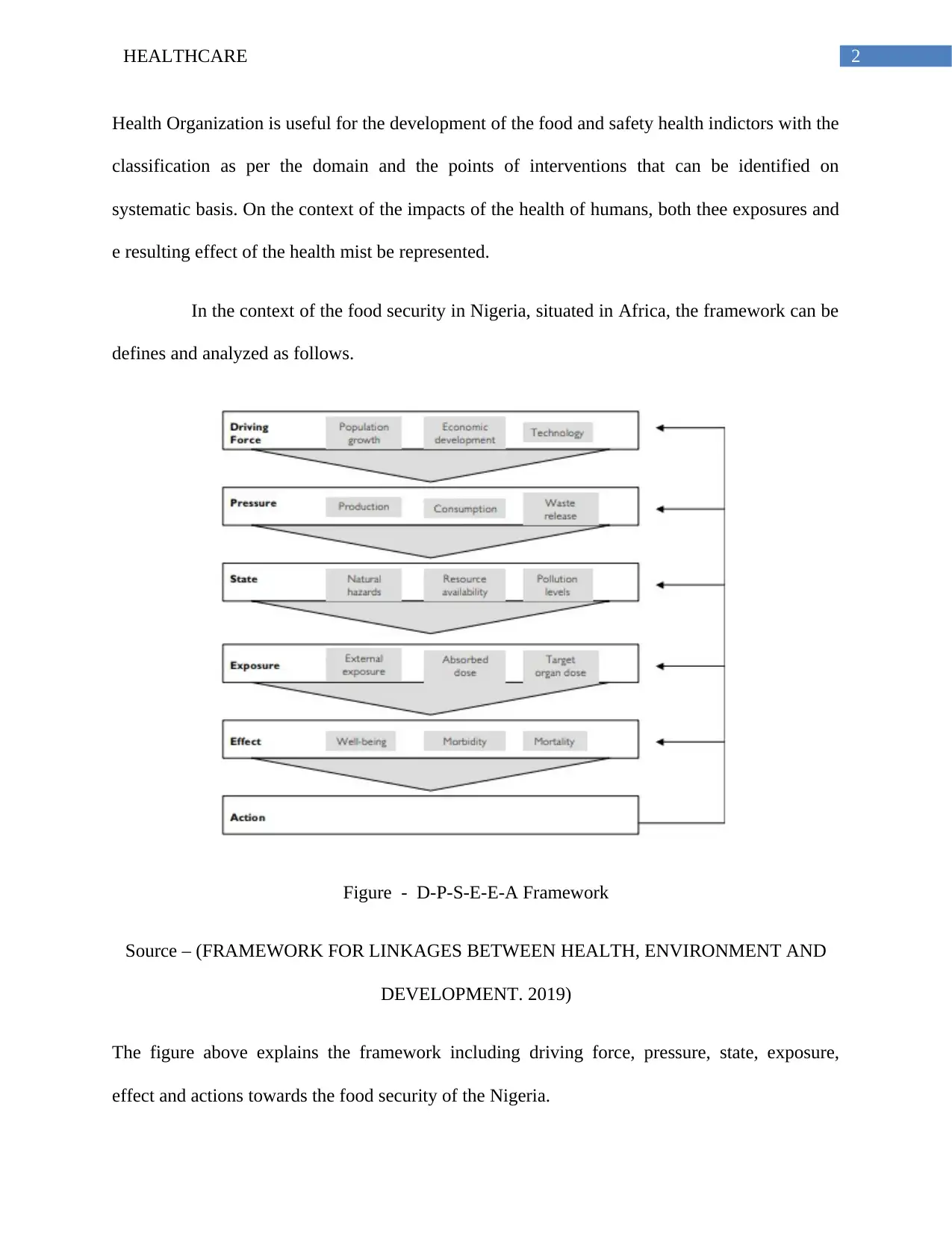
2HEALTHCARE
Health Organization is useful for the development of the food and safety health indictors with the
classification as per the domain and the points of interventions that can be identified on
systematic basis. On the context of the impacts of the health of humans, both thee exposures and
e resulting effect of the health mist be represented.
In the context of the food security in Nigeria, situated in Africa, the framework can be
defines and analyzed as follows.
Figure - D-P-S-E-E-A Framework
Source – (FRAMEWORK FOR LINKAGES BETWEEN HEALTH, ENVIRONMENT AND
DEVELOPMENT. 2019)
The figure above explains the framework including driving force, pressure, state, exposure,
effect and actions towards the food security of the Nigeria.
Health Organization is useful for the development of the food and safety health indictors with the
classification as per the domain and the points of interventions that can be identified on
systematic basis. On the context of the impacts of the health of humans, both thee exposures and
e resulting effect of the health mist be represented.
In the context of the food security in Nigeria, situated in Africa, the framework can be
defines and analyzed as follows.
Figure - D-P-S-E-E-A Framework
Source – (FRAMEWORK FOR LINKAGES BETWEEN HEALTH, ENVIRONMENT AND
DEVELOPMENT. 2019)
The figure above explains the framework including driving force, pressure, state, exposure,
effect and actions towards the food security of the Nigeria.

3HEALTHCARE
The driving forces - The excessive growth of population in the state of Nigeria in Africa,
together with the lack of proper economic development due to the poverty and unemployment
are some of the contributing factors. Furthermore technology plays a very essential role in the
driving force for this environmental health hazard.
The pressure –The effectiveness of production of food disrupts the nutritional factors regarding
the nutrition and the food rate sufficiency that results to wastage on post-harvest. The access and
the choice together with the resource utilization with the resource stability contributes to the
major factors that hinders the food security, convenience and nutrition of the people of
Nigeria(Benson et al., 2017). This furthermore increases the challenges and the issues related to
the environmental health of the food security in Nigeria. The waste formed are not effectively
released in the country resulting in disease and health challenges.
State – The effect of the natural disaster in the agricultural sector of Africa absorbs more than 25
percent of the total damage and losses. The impact of the natural disaster over the production and
the security of the food in the country is severe. In Africa, drought is one of the challenging
factor resulting in losing up of 20 percent of the agricultural and food problem. Climatological
and meteorological disaster like storms, extreme temperature and wildfires. Besides, geophysical
disaster like tsunamis, earthquakes and mass movements contributes to the challenge for the
security of the food in the country (Matemilola & Elegbede, 2017). The pollution caused due to
climate change influences the lack of nutritional security.
Exposure – The external exposure to insufficient production in the country which is a barrier for
enabling the sufficiency of food to the people in country. The increased rate of poverty within
the country are the absorbed dose and the target organ dose for the country.
The driving forces - The excessive growth of population in the state of Nigeria in Africa,
together with the lack of proper economic development due to the poverty and unemployment
are some of the contributing factors. Furthermore technology plays a very essential role in the
driving force for this environmental health hazard.
The pressure –The effectiveness of production of food disrupts the nutritional factors regarding
the nutrition and the food rate sufficiency that results to wastage on post-harvest. The access and
the choice together with the resource utilization with the resource stability contributes to the
major factors that hinders the food security, convenience and nutrition of the people of
Nigeria(Benson et al., 2017). This furthermore increases the challenges and the issues related to
the environmental health of the food security in Nigeria. The waste formed are not effectively
released in the country resulting in disease and health challenges.
State – The effect of the natural disaster in the agricultural sector of Africa absorbs more than 25
percent of the total damage and losses. The impact of the natural disaster over the production and
the security of the food in the country is severe. In Africa, drought is one of the challenging
factor resulting in losing up of 20 percent of the agricultural and food problem. Climatological
and meteorological disaster like storms, extreme temperature and wildfires. Besides, geophysical
disaster like tsunamis, earthquakes and mass movements contributes to the challenge for the
security of the food in the country (Matemilola & Elegbede, 2017). The pollution caused due to
climate change influences the lack of nutritional security.
Exposure – The external exposure to insufficient production in the country which is a barrier for
enabling the sufficiency of food to the people in country. The increased rate of poverty within
the country are the absorbed dose and the target organ dose for the country.
Secure Best Marks with AI Grader
Need help grading? Try our AI Grader for instant feedback on your assignments.
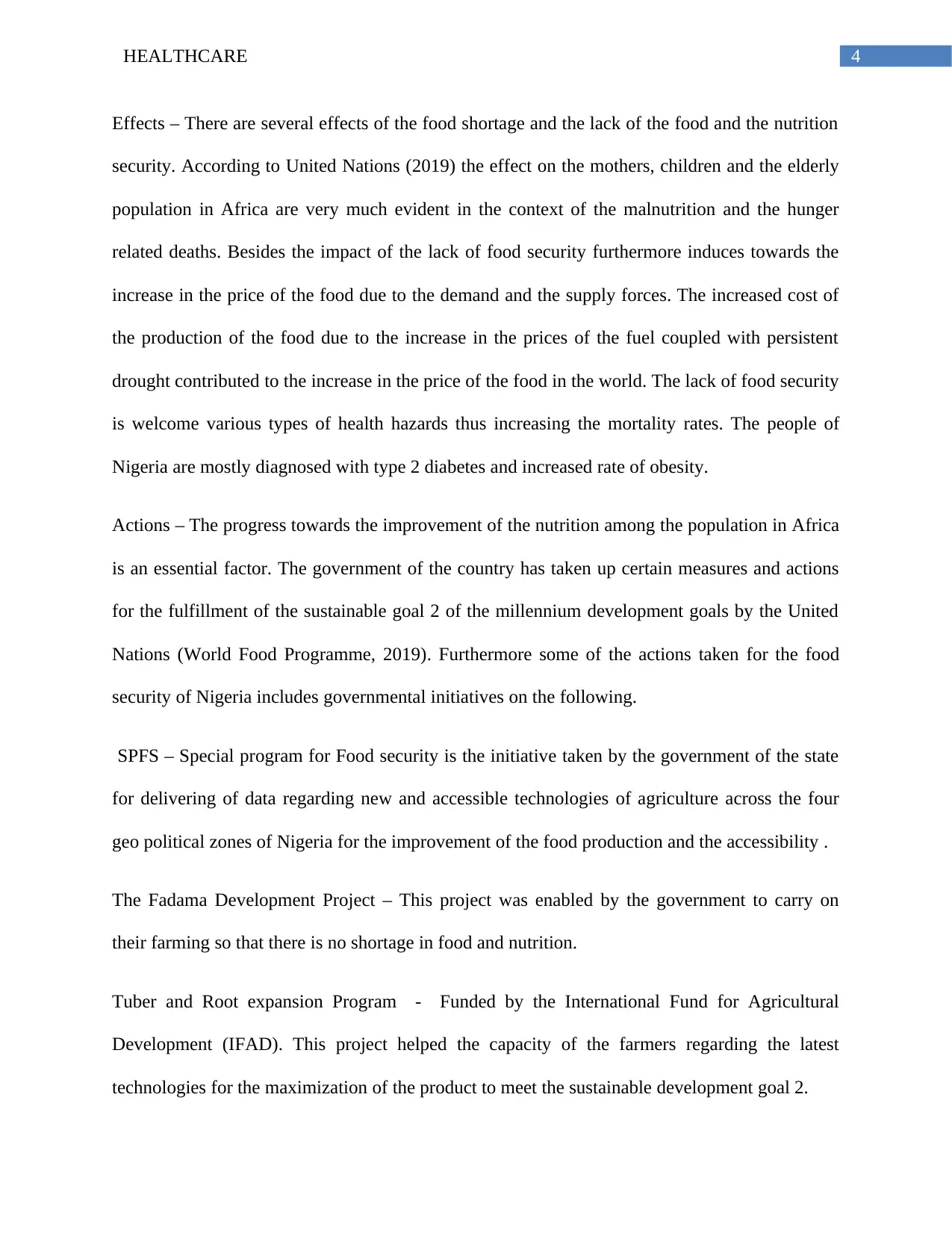
4HEALTHCARE
Effects – There are several effects of the food shortage and the lack of the food and the nutrition
security. According to United Nations (2019) the effect on the mothers, children and the elderly
population in Africa are very much evident in the context of the malnutrition and the hunger
related deaths. Besides the impact of the lack of food security furthermore induces towards the
increase in the price of the food due to the demand and the supply forces. The increased cost of
the production of the food due to the increase in the prices of the fuel coupled with persistent
drought contributed to the increase in the price of the food in the world. The lack of food security
is welcome various types of health hazards thus increasing the mortality rates. The people of
Nigeria are mostly diagnosed with type 2 diabetes and increased rate of obesity.
Actions – The progress towards the improvement of the nutrition among the population in Africa
is an essential factor. The government of the country has taken up certain measures and actions
for the fulfillment of the sustainable goal 2 of the millennium development goals by the United
Nations (World Food Programme, 2019). Furthermore some of the actions taken for the food
security of Nigeria includes governmental initiatives on the following.
SPFS – Special program for Food security is the initiative taken by the government of the state
for delivering of data regarding new and accessible technologies of agriculture across the four
geo political zones of Nigeria for the improvement of the food production and the accessibility .
The Fadama Development Project – This project was enabled by the government to carry on
their farming so that there is no shortage in food and nutrition.
Tuber and Root expansion Program - Funded by the International Fund for Agricultural
Development (IFAD). This project helped the capacity of the farmers regarding the latest
technologies for the maximization of the product to meet the sustainable development goal 2.
Effects – There are several effects of the food shortage and the lack of the food and the nutrition
security. According to United Nations (2019) the effect on the mothers, children and the elderly
population in Africa are very much evident in the context of the malnutrition and the hunger
related deaths. Besides the impact of the lack of food security furthermore induces towards the
increase in the price of the food due to the demand and the supply forces. The increased cost of
the production of the food due to the increase in the prices of the fuel coupled with persistent
drought contributed to the increase in the price of the food in the world. The lack of food security
is welcome various types of health hazards thus increasing the mortality rates. The people of
Nigeria are mostly diagnosed with type 2 diabetes and increased rate of obesity.
Actions – The progress towards the improvement of the nutrition among the population in Africa
is an essential factor. The government of the country has taken up certain measures and actions
for the fulfillment of the sustainable goal 2 of the millennium development goals by the United
Nations (World Food Programme, 2019). Furthermore some of the actions taken for the food
security of Nigeria includes governmental initiatives on the following.
SPFS – Special program for Food security is the initiative taken by the government of the state
for delivering of data regarding new and accessible technologies of agriculture across the four
geo political zones of Nigeria for the improvement of the food production and the accessibility .
The Fadama Development Project – This project was enabled by the government to carry on
their farming so that there is no shortage in food and nutrition.
Tuber and Root expansion Program - Funded by the International Fund for Agricultural
Development (IFAD). This project helped the capacity of the farmers regarding the latest
technologies for the maximization of the product to meet the sustainable development goal 2.
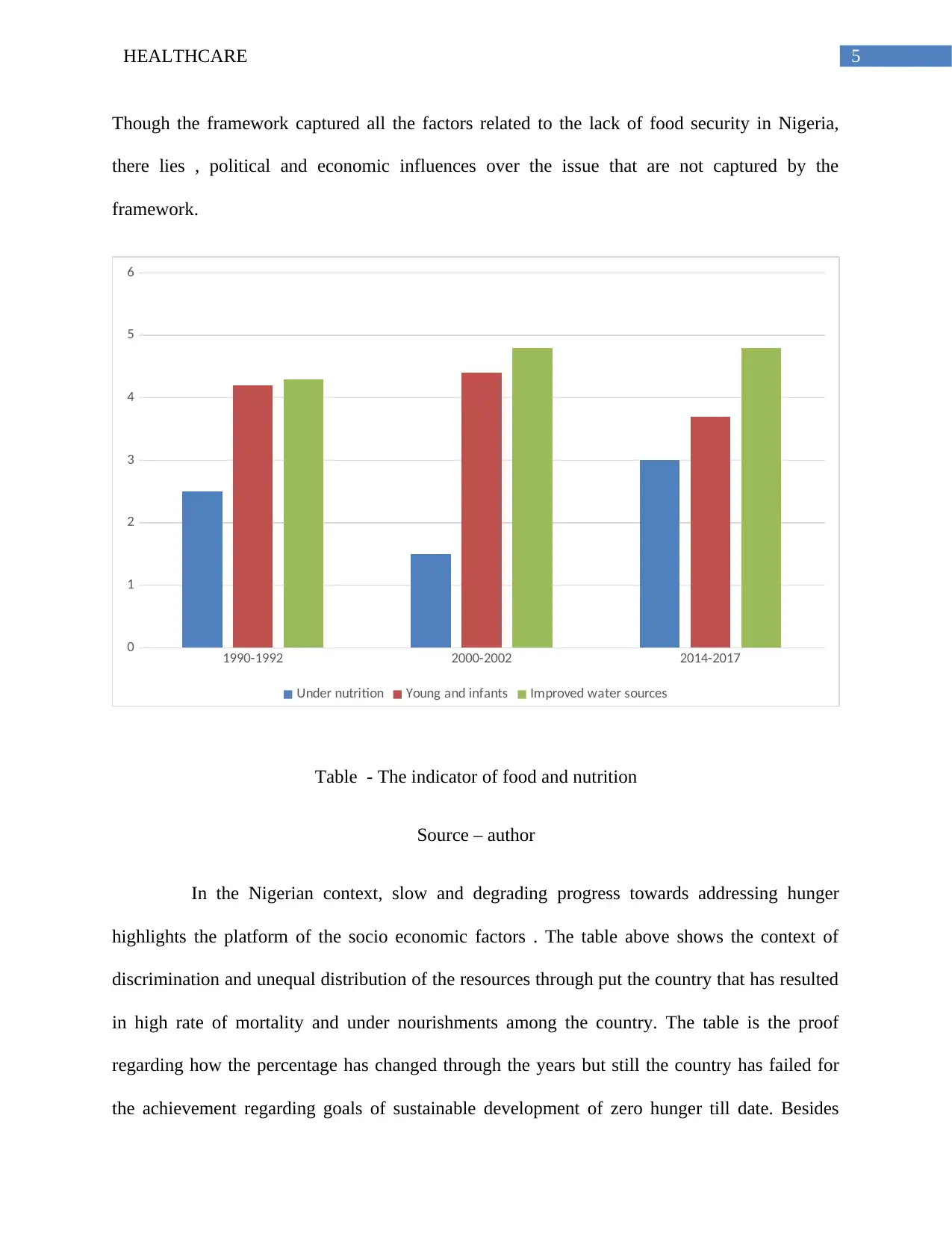
5HEALTHCARE
Though the framework captured all the factors related to the lack of food security in Nigeria,
there lies , political and economic influences over the issue that are not captured by the
framework.
Table - The indicator of food and nutrition
Source – author
In the Nigerian context, slow and degrading progress towards addressing hunger
highlights the platform of the socio economic factors . The table above shows the context of
discrimination and unequal distribution of the resources through put the country that has resulted
in high rate of mortality and under nourishments among the country. The table is the proof
regarding how the percentage has changed through the years but still the country has failed for
the achievement regarding goals of sustainable development of zero hunger till date. Besides
1990-1992 2000-2002 2014-2017
0
1
2
3
4
5
6
Under nutrition Young and infants Improved water sources
Though the framework captured all the factors related to the lack of food security in Nigeria,
there lies , political and economic influences over the issue that are not captured by the
framework.
Table - The indicator of food and nutrition
Source – author
In the Nigerian context, slow and degrading progress towards addressing hunger
highlights the platform of the socio economic factors . The table above shows the context of
discrimination and unequal distribution of the resources through put the country that has resulted
in high rate of mortality and under nourishments among the country. The table is the proof
regarding how the percentage has changed through the years but still the country has failed for
the achievement regarding goals of sustainable development of zero hunger till date. Besides
1990-1992 2000-2002 2014-2017
0
1
2
3
4
5
6
Under nutrition Young and infants Improved water sources
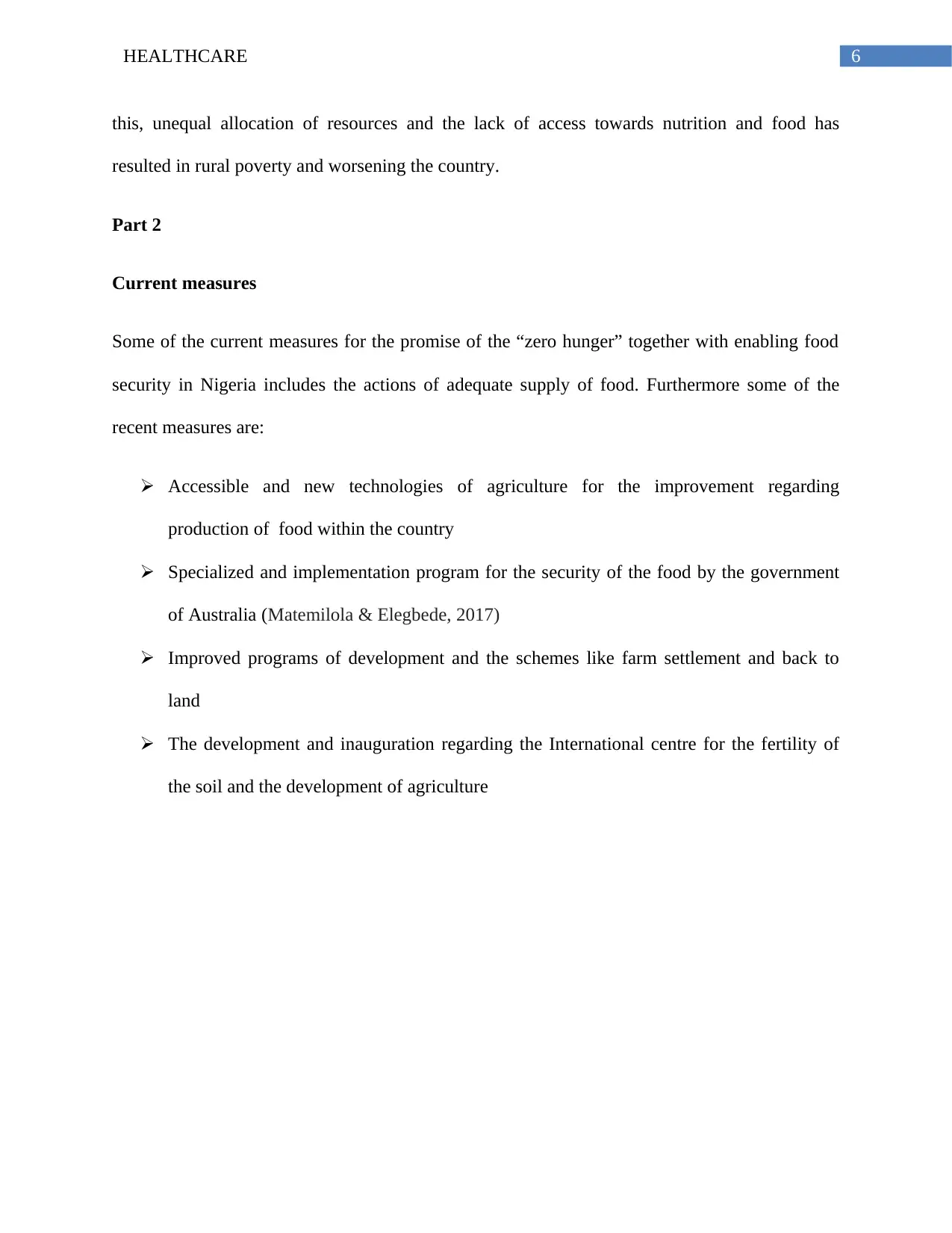
6HEALTHCARE
this, unequal allocation of resources and the lack of access towards nutrition and food has
resulted in rural poverty and worsening the country.
Part 2
Current measures
Some of the current measures for the promise of the “zero hunger” together with enabling food
security in Nigeria includes the actions of adequate supply of food. Furthermore some of the
recent measures are:
Accessible and new technologies of agriculture for the improvement regarding
production of food within the country
Specialized and implementation program for the security of the food by the government
of Australia (Matemilola & Elegbede, 2017)
Improved programs of development and the schemes like farm settlement and back to
land
The development and inauguration regarding the International centre for the fertility of
the soil and the development of agriculture
this, unequal allocation of resources and the lack of access towards nutrition and food has
resulted in rural poverty and worsening the country.
Part 2
Current measures
Some of the current measures for the promise of the “zero hunger” together with enabling food
security in Nigeria includes the actions of adequate supply of food. Furthermore some of the
recent measures are:
Accessible and new technologies of agriculture for the improvement regarding
production of food within the country
Specialized and implementation program for the security of the food by the government
of Australia (Matemilola & Elegbede, 2017)
Improved programs of development and the schemes like farm settlement and back to
land
The development and inauguration regarding the International centre for the fertility of
the soil and the development of agriculture
Paraphrase This Document
Need a fresh take? Get an instant paraphrase of this document with our AI Paraphraser
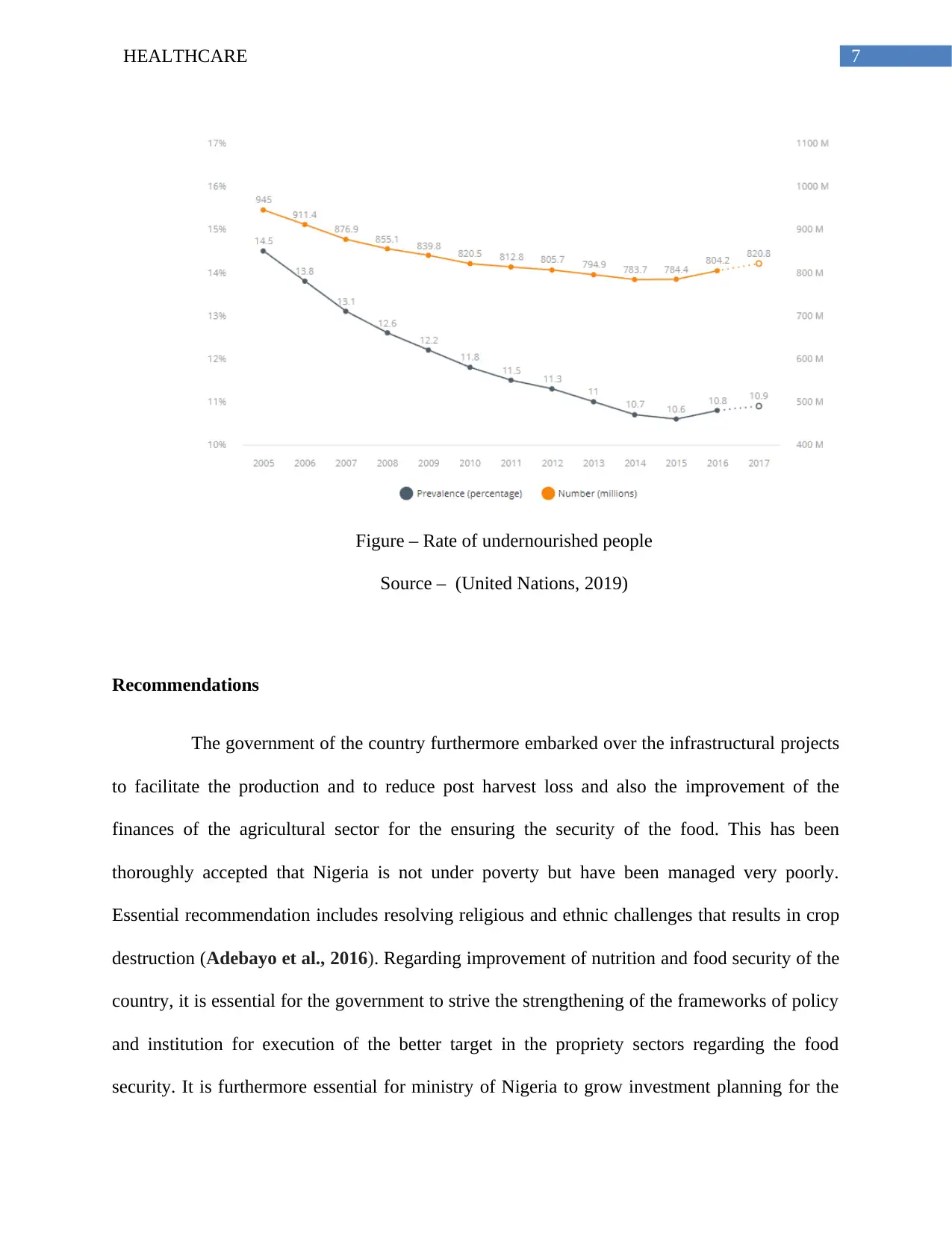
7HEALTHCARE
Figure – Rate of undernourished people
Source – (United Nations, 2019)
Recommendations
The government of the country furthermore embarked over the infrastructural projects
to facilitate the production and to reduce post harvest loss and also the improvement of the
finances of the agricultural sector for the ensuring the security of the food. This has been
thoroughly accepted that Nigeria is not under poverty but have been managed very poorly.
Essential recommendation includes resolving religious and ethnic challenges that results in crop
destruction (Adebayo et al., 2016). Regarding improvement of nutrition and food security of the
country, it is essential for the government to strive the strengthening of the frameworks of policy
and institution for execution of the better target in the propriety sectors regarding the food
security. It is furthermore essential for ministry of Nigeria to grow investment planning for the
Figure – Rate of undernourished people
Source – (United Nations, 2019)
Recommendations
The government of the country furthermore embarked over the infrastructural projects
to facilitate the production and to reduce post harvest loss and also the improvement of the
finances of the agricultural sector for the ensuring the security of the food. This has been
thoroughly accepted that Nigeria is not under poverty but have been managed very poorly.
Essential recommendation includes resolving religious and ethnic challenges that results in crop
destruction (Adebayo et al., 2016). Regarding improvement of nutrition and food security of the
country, it is essential for the government to strive the strengthening of the frameworks of policy
and institution for execution of the better target in the propriety sectors regarding the food
security. It is furthermore essential for ministry of Nigeria to grow investment planning for the
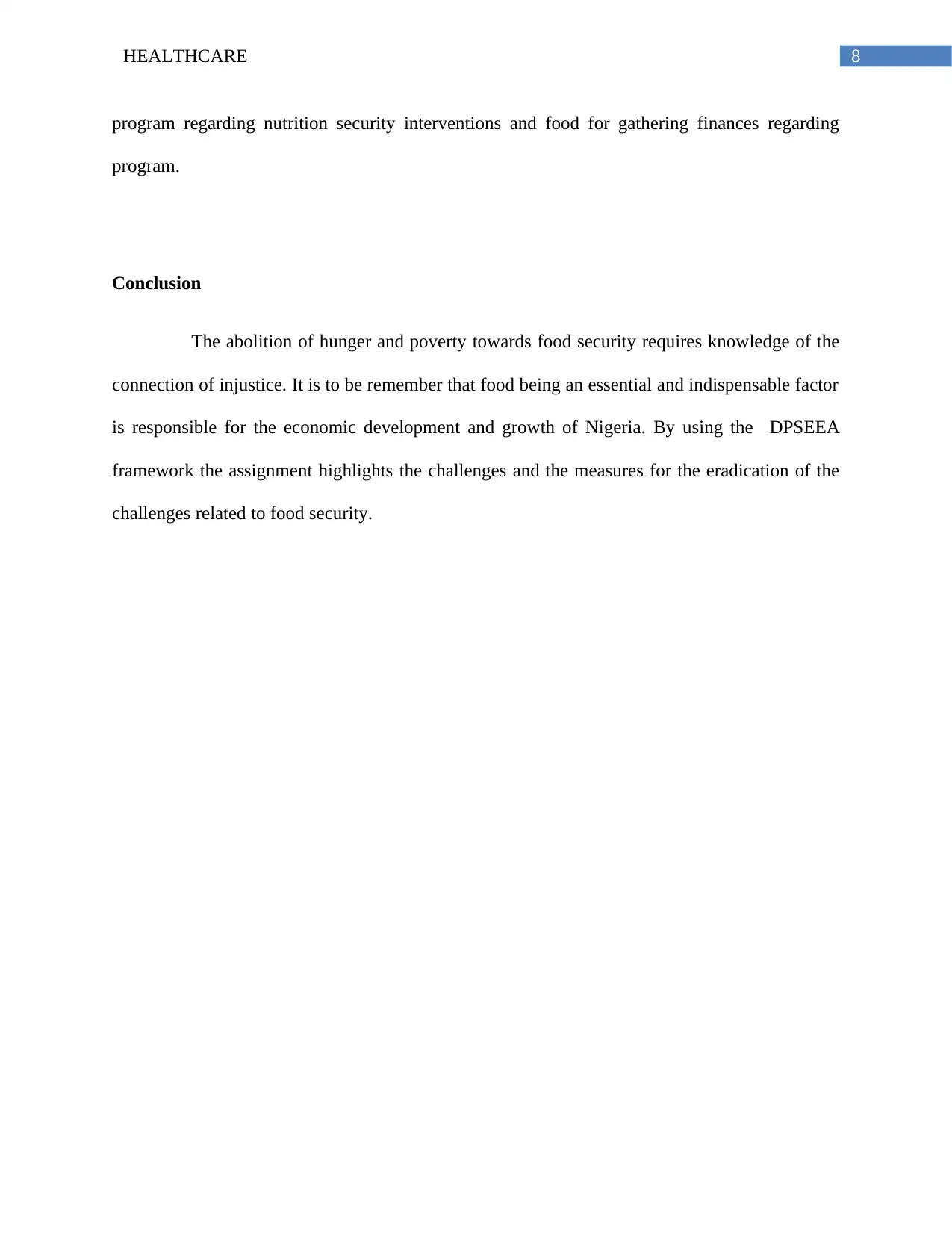
8HEALTHCARE
program regarding nutrition security interventions and food for gathering finances regarding
program.
Conclusion
The abolition of hunger and poverty towards food security requires knowledge of the
connection of injustice. It is to be remember that food being an essential and indispensable factor
is responsible for the economic development and growth of Nigeria. By using the DPSEEA
framework the assignment highlights the challenges and the measures for the eradication of the
challenges related to food security.
program regarding nutrition security interventions and food for gathering finances regarding
program.
Conclusion
The abolition of hunger and poverty towards food security requires knowledge of the
connection of injustice. It is to be remember that food being an essential and indispensable factor
is responsible for the economic development and growth of Nigeria. By using the DPSEEA
framework the assignment highlights the challenges and the measures for the eradication of the
challenges related to food security.
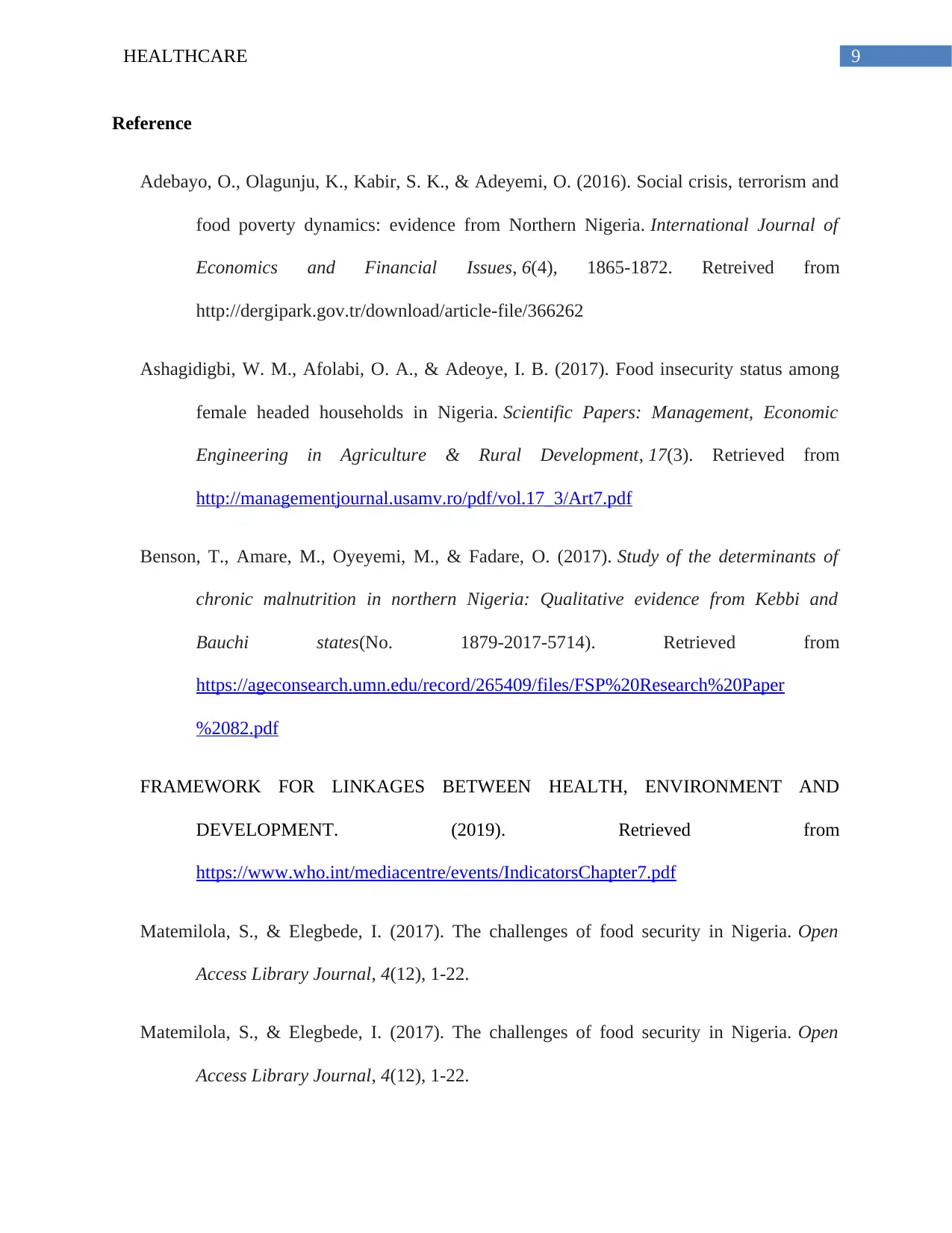
9HEALTHCARE
Reference
Adebayo, O., Olagunju, K., Kabir, S. K., & Adeyemi, O. (2016). Social crisis, terrorism and
food poverty dynamics: evidence from Northern Nigeria. International Journal of
Economics and Financial Issues, 6(4), 1865-1872. Retreived from
http://dergipark.gov.tr/download/article-file/366262
Ashagidigbi, W. M., Afolabi, O. A., & Adeoye, I. B. (2017). Food insecurity status among
female headed households in Nigeria. Scientific Papers: Management, Economic
Engineering in Agriculture & Rural Development, 17(3). Retrieved from
http://managementjournal.usamv.ro/pdf/vol.17_3/Art7.pdf
Benson, T., Amare, M., Oyeyemi, M., & Fadare, O. (2017). Study of the determinants of
chronic malnutrition in northern Nigeria: Qualitative evidence from Kebbi and
Bauchi states(No. 1879-2017-5714). Retrieved from
https://ageconsearch.umn.edu/record/265409/files/FSP%20Research%20Paper
%2082.pdf
FRAMEWORK FOR LINKAGES BETWEEN HEALTH, ENVIRONMENT AND
DEVELOPMENT. (2019). Retrieved from
https://www.who.int/mediacentre/events/IndicatorsChapter7.pdf
Matemilola, S., & Elegbede, I. (2017). The challenges of food security in Nigeria. Open
Access Library Journal, 4(12), 1-22.
Matemilola, S., & Elegbede, I. (2017). The challenges of food security in Nigeria. Open
Access Library Journal, 4(12), 1-22.
Reference
Adebayo, O., Olagunju, K., Kabir, S. K., & Adeyemi, O. (2016). Social crisis, terrorism and
food poverty dynamics: evidence from Northern Nigeria. International Journal of
Economics and Financial Issues, 6(4), 1865-1872. Retreived from
http://dergipark.gov.tr/download/article-file/366262
Ashagidigbi, W. M., Afolabi, O. A., & Adeoye, I. B. (2017). Food insecurity status among
female headed households in Nigeria. Scientific Papers: Management, Economic
Engineering in Agriculture & Rural Development, 17(3). Retrieved from
http://managementjournal.usamv.ro/pdf/vol.17_3/Art7.pdf
Benson, T., Amare, M., Oyeyemi, M., & Fadare, O. (2017). Study of the determinants of
chronic malnutrition in northern Nigeria: Qualitative evidence from Kebbi and
Bauchi states(No. 1879-2017-5714). Retrieved from
https://ageconsearch.umn.edu/record/265409/files/FSP%20Research%20Paper
%2082.pdf
FRAMEWORK FOR LINKAGES BETWEEN HEALTH, ENVIRONMENT AND
DEVELOPMENT. (2019). Retrieved from
https://www.who.int/mediacentre/events/IndicatorsChapter7.pdf
Matemilola, S., & Elegbede, I. (2017). The challenges of food security in Nigeria. Open
Access Library Journal, 4(12), 1-22.
Matemilola, S., & Elegbede, I. (2017). The challenges of food security in Nigeria. Open
Access Library Journal, 4(12), 1-22.
Secure Best Marks with AI Grader
Need help grading? Try our AI Grader for instant feedback on your assignments.
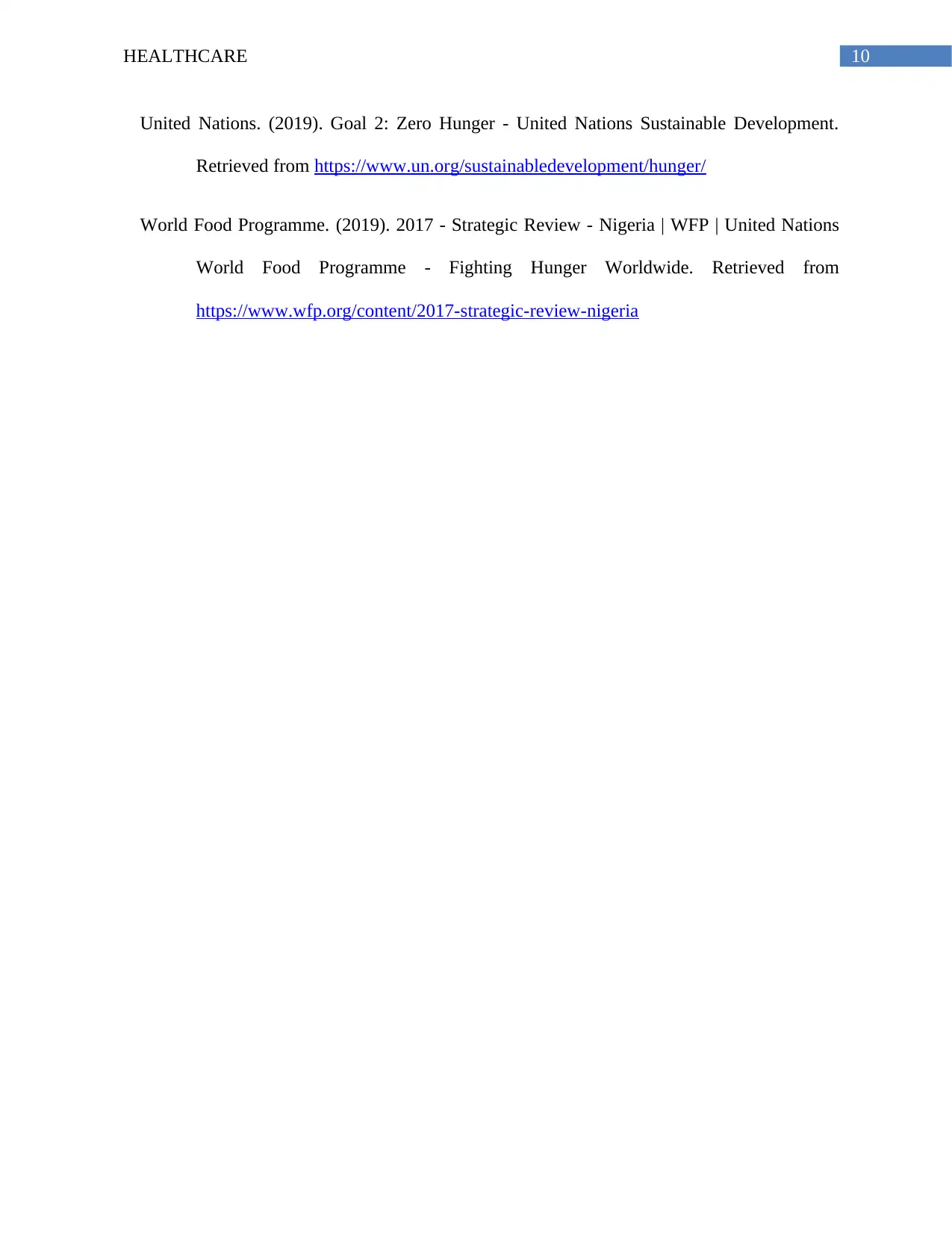
10HEALTHCARE
United Nations. (2019). Goal 2: Zero Hunger - United Nations Sustainable Development.
Retrieved from https://www.un.org/sustainabledevelopment/hunger/
World Food Programme. (2019). 2017 - Strategic Review - Nigeria | WFP | United Nations
World Food Programme - Fighting Hunger Worldwide. Retrieved from
https://www.wfp.org/content/2017-strategic-review-nigeria
United Nations. (2019). Goal 2: Zero Hunger - United Nations Sustainable Development.
Retrieved from https://www.un.org/sustainabledevelopment/hunger/
World Food Programme. (2019). 2017 - Strategic Review - Nigeria | WFP | United Nations
World Food Programme - Fighting Hunger Worldwide. Retrieved from
https://www.wfp.org/content/2017-strategic-review-nigeria
1 out of 11
Related Documents
Your All-in-One AI-Powered Toolkit for Academic Success.
+13062052269
info@desklib.com
Available 24*7 on WhatsApp / Email
![[object Object]](/_next/static/media/star-bottom.7253800d.svg)
Unlock your academic potential
© 2024 | Zucol Services PVT LTD | All rights reserved.





